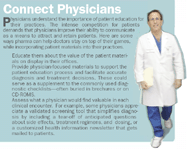Direct to Consumer: Patient Education Reform
Patient materials should reflect what patients want to know in a language they can quickly understand.
Patient education materials may not be doing their job. Surveys show they have done little to improve patients' understanding of their treatment regimens or to enhance the patient-physician interaction. In fact, half of all patients leave the doctor's office confused about their treatment plan, and only 15 percent fully understand what doctors tell them, according to the Center for Health Policy and Research. The familiar brochures, tent-cards, checklists, posters, and newsletters—mainstays of physicians' offices and waiting rooms—serve as important resources for patients. But they often don't speak to patients in a language they can understand. Full of jargon and promotional talk, they leave patients feeling uninformed and disempowered when they should do just the opposite—stimulate a dialogue with doctors about available treatments and encourage patients to take an active approach to their healthcare. While these direct-to-patient (DTP)materials represent an important opportunity for pharma marketers, they desperately need a makeover.

Maggie Helmig
Integrate the Message
For marketers, the doctor's office or waiting room represents an ideal setting to reach patients. It is there that patients are focused on their health and well being, and can immediately act on information they receive. If prompted by the right communication tools, patients can use these materials to open a dialogue with their doctor about a product they just learned about, and would have otherwise never considered. Therefore, a successful DTP campaign benefits from patient involvement and physician buy-in.

Connect Physicians
A recent campaign for a contraceptive exemplifies how patient materials can bring consumers and doctors together. The campaign incorporates questions that patients can immediately relate to—focusing on whether the contraceptive they currently use represents the best choice given their hectic lives—into office posters, brochures, and a physician questionnaire for use during office visit. The poster prompted patients to ask themselves whether their method gave them the ease, convenience, and freedom they craved. It hit a nerve with today's time-crunched women, prompting them to re-think an important health issue at the right time and place—while waiting to see their physician. Meanwhile, marketers had filled in physicians on the latest data about patients and contraceptive use. The program armed physicians with an office screener to help assess whether a patient was a good candidate for the product; it also prepared them to answer typical patient questions. As a result, the company reported strong sales and high levels of patient satisfaction with the product.

Materials That Dispel Myths
When Patient Materials Go Wrong
Creating effective patient materials can be challenging. Often developed from a traditional advertising perspective, materials tend to sell and push, rather than support and guide patients. As a result, they often don't reflect what patients want to know. They assume that patients understand pharma phrases and medical terminology, asking questions that patients aren't likely to ask, and omitting information that patients may consider crucial. For example, phrases like "adverse events" and "presenting symptoms" can be jarring and foreign-sounding. Despite more talk about health literacy, pharma materials have yet to embrace this concept. Instead, they incorrectly assume that more educated patients find it easier to comprehend medical information. But, unlike marketers and healthcare professionals, consumers—regardless of education levels—aren't steeped in health information and jargon.
Some materials do not address patient's most basic concerns. In one example, a first draft of a brochure promoting an antibiotic treatment posed hypotheticals, such as,"If you take antibiotics when you don't need them, they may not work when you do." This indirect approach confused patients. The re-draft, however, spoke to patients using straightforward, declarative sentences: "Don't take antibiotics when you don't need them, because they may not work when you do need them."
Flawed ADHD Brochure
A brochure for parents of children diagnosed with attention deficit hyperactivity disorder (ADHD) demonstrates another flaw in patient materials. While the brochure boasted an inviting design and helpful information, it lacked a clear discussion of side effects, which made parents uneasy. Marketers should have better displayed the information on side effects to make parents feel more confident about treatment options for their children.
Marketers must understand how the patient-physician relationship impacts marketing. To spread a message about a product, marketers must bring educational value to both parties. Effective patient materials encourage patients to talk to their doctors about the product, and make it easer for doctors to understand and promote the product. Marketers must take the time to increase their patient IQ and view materials through patients' eyes.
People Chris Foster rejoined Burson-Marsteller as managing director of its global healthcare practice. Sarah Wilcox was promoted to executive vice president and director of Draft Health. Abelson-Taylor hired four clinical research associates: Jonathan Davila, Rose Marie Cassey, Radu Postelnicu, and Lucy Chung. James Giffin joined Creotex Communications as director of strategic planning and business development.

Shireen Bashir, Sanofi Pasteur Kerry Ann Clawson, Accent Health
Awards Adair-Greene was invited to participate in the 3rd Annual One Show Rx exhibition, honoring excellence in advertising. It was chosen for its ad for Ceralyte, for Attention Deficit Disorder. Ventiv Health celebrated its 10th anniversary with a party hosted by Dr. Sanjay Gupta. Palio Communications recieved a gold award at the MarCom Creative Awards for a campaign created for Celegene Cellular Therapeutics and LifeBankUSA
Launches Corbett Accel Healthcare Group launched a new business unit, Surge Worldwide Healthcare Communications, as a spin-off of its New York office. The AIDS Healthcare Foundation unveiled a new ad campaign, "HIV-Not Fabulous," produced by Better World Advertising.
Accounts Adair-Green was selected as Stiefel Laboratories' agency of record for two dermatology products: acne drug Duac and MimyX Cream for eczema. Edelman was selected as the agency of record for the American Heart Association's Go Red for Women movement to prevent cardiovascular disease.
Maggie Helmig is president of Eden Communications Group. She can be reached at mhelmig@edencomgroup.com

The Misinformation Maze: Navigating Public Health in the Digital Age
March 11th 2025Jennifer Butler, chief commercial officer of Pleio, discusses misinformation's threat to public health, where patients are turning for trustworthy health information, the industry's pivot to peer-to-patient strategies to educate patients, and more.
Navigating Distrust: Pharma in the Age of Social Media
February 18th 2025Ian Baer, Founder and CEO of Sooth, discusses how the growing distrust in social media will impact industry marketing strategies and the relationships between pharmaceutical companies and the patients they aim to serve. He also explains dark social, how to combat misinformation, closing the trust gap, and more.